While some of the best TVs on the market feature the smartest interfaces to date, they still come with their limitations. Perhaps your favorite apps aren’t supported or your go-to streaming service isn’t built in.
The solution? Streaming sticks and boxes. These handy devices enhance even the smartest of TVs, enabling users to access tons of streaming services and cast content from their phone, tablet or laptop. A good streaming stick or box can actually help lengthen a TV’s lifespan by adding smarts and upgrading picture quality so you don’t have to upgrade as often.
You may already be familiar with the heavy hitters in the streaming sticks domain — Roku, Amazon’s Fire TV Stick, Apple TV and Google’s Chromecast — but picking the right one isn’t always a simple choice. Which serves the most use cases? Which is best for your particular needs? What does each bring to the viewing experience? And which will stretch your dollars furthest?
To solve your analysis paralysis, we tested 10 of the top streaming sticks and boxes and found three devices that stood out from the pack:
A quick look at the winners
Roku’s Ultra streaming box is one of the more powerful devices we tested. There’s almost zero lag time between waking it up and streaming content, leading to a hiccup-free streaming experience. On top of that, the Roku Ultra can upscale content to deliver the best picture possible on your TV — even on older-model TVs that don’t offer the latest and greatest picture quality — and supports everything from HD to 4K. While all of our top picks meet the 4K threshold, the Ultra does so at a noticeably quicker rate, so you’ll never experience content that skips or appears blurry for a few frames. At $99.99, the Roku Ultra undercuts other big hitters like the Fire TV Cube and Apple TV 4K. While it’s not as full-featured as the latter (namely, the Roku doesn’t offer Peacock or HBO Max), you’re not sacrificing much, if anything, in terms of everyday streaming quality. It’s the perfect cross-section of value and performance for most consumers.
For an extra $80, the Apple TV 4K takes things a bit further, as it’s the only streamer we tested that supports Peacock and HBO Max in addition to the same thousands of streaming options you get with the Roku Ultra. It similarly upscales content to 4K UHD quality with support for HDR but steps that up a few notches with support for Dolby Vision and Dolby Atmos, which work with supported content to increase highlights and contrast. Since it’s deeply integrated with your iPhone (and, really, any Apple-made device), it allows you to autofill logins for services, use your iOS keyboard for easier typing and cast content via AirPlay 2 to easily get photos or videos on the big screen.
At a wallet-friendly $49.99, the Fire TV Stick 4K performed superbly in our testing. It has the necessary tropes like 4K HDR quality and a host of streaming services. Though the user interface is a bit cluttered, the processor inside allows you to navigate it with ease. Better yet, it’s tied to your Amazon account out of the box and will already have some recommended content for you based on past viewing behaviors. Alexa is built in to handle your entertainment requests but can also be used to control your smart home. While Roku has a wider selection of services (Vudu and Google Play Store are not on board here), the Stick 4K has the core services covered, like Netflix and Hulu, at half the price as our top pick.
A deeper dive into the winners
Best overall streaming device: Roku Ultra ($99.99; amazon.com or roku.com)
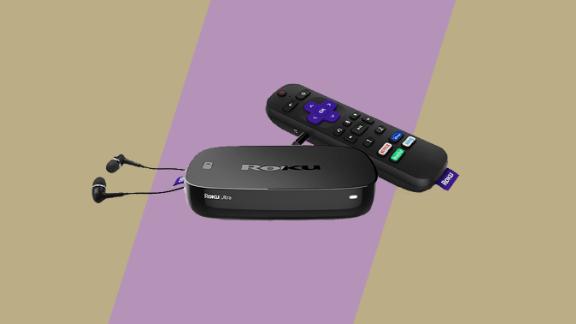
From the moment you switch it on, the Roku Ultra presents one of the most seamless experiences of any streaming device we tested.
It was easier and quicker to locate preferred apps and services and to move those used most to a higher spot for even quicker access compared to other devices we tested. We were able to open Netflix, select “Parks and Recreation” and be in the world of Pawnee, Indiana, in about 10 seconds flat.
That swiftness is thanks to its quad-core processor and improved Wi-Fi, which makes the Ultra noticeably faster than other streaming devices we tested. Comparatively, the Roku Premiere takes a handful of seconds to open up an app and a few more seconds to start a stream.
Roku Ultra automatically upscales content to the highest resolution your TV can handle, up to 4K, and calibrates it to make sure it’s optimized for your screen. So if you’re streaming 720p content on a 1080p TV, it will upscale to that resolution, or if you have a 4K TV, it will deliver it at a full 4K resolution.
Content looks great, and HDR really shines. In action titles, such as “Fast & Furious” and “Star Wars,” we didn’t experience any skips in fast scenes, and colors were vibrant but not overexposed. We wish Dolby Vision and Dolby Atmos were supported here, though.
Roku has access to some of the most popular streaming services: Netflix, Hulu, YouTube, Sling TV, AT&T TV, Philo, Disney+, Apple TV+ and Amazon Prime Video are all supported, though Peacock and HBO Max are absent.
The cherry on top is the included remote, which provides a simple layout with navigation buttons, voice functionality and volume controls. There’s a headphone jack built right in for personal listening (earbuds are even included in the box), and it has a speaker built in so you can ping the remote if it gets misplaced or lost in the couch cushions.
If you’re looking for a streaming box that’s fast, responsive and future-proofed with features, the Roku Ultra delivers at a reasonable price point of $99.99.
The upgrade pick: Apple TV 4K ($179.95; bhphotovideo.com)
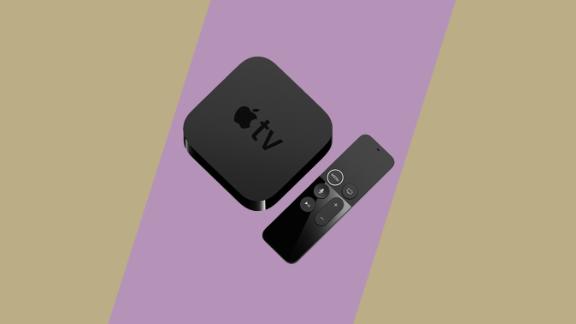
The Apple TV 4K kicks things up a notch compared to the Roku Ultra. This streaming box isn’t just for binge-watching. Sure, it has access to all the streaming services you’ll get with other devices, but it also throws in gaming and countless additional apps.
Apple TV is similar to the experience on your iPad or iPhone, especially since it’s powered by the same chip architecture. That means it can handle having multiple streaming services open all at once (much like how you can multitask between different apps on the iPad). You can quickly switch between Netflix and opt to open Disney+ without experiencing any slowdowns. At times, other devices we tested experienced delays when going back to the home screen, but it’s a fluid transition that instantly happens on the Apple TV 4K.
This streaming box also works flawlessly for anyone within the Apple ecosystem or those looking to get more out of a streaming box. For instance, when you hit a text field, you’ll get a notification on your iPhone that allows you to use that keyboard to type on your TV screen. It’s leagues better than locating and selecting one letter at a time with a TV remote. It can also autofill an email field for you, and you can access your iCloud Keychain to auto-complete logins to services. It worked like a charm when we tried it on Netflix.
There are lots of little conveniences like this that make this a really great choice for Apple users. Navigating through the built-in apps, searching the App Store and tweaking settings are all quick and easy tasks, and the interface will be familiar to anyone with an iPad or iPhone.
Via the App Store, you can find most of the major services: Netflix, Hulu, Disney+, Sling TV, YouTube, YouTube TV, AT&T TV, Philo and tons of others. Apple even has HBO Max and Peacock. These services are mixed with other core apps, including Facebook’s Apple TV app, which focuses on Facebook Watch. You can also find games, such as “Crossy Road,” which translate well to the Apple TV 4K since the included remote has both a large trackpad-like top and a bunch of sensors inside. For racing games, you can turn it left or right, in the same view you’d play on an iPhone. There are a bunch of Apple Arcade titles available as well.
Aside from the various streaming options you have through the box itself, you can also cast content with AirPlay or AirPlay 2 from your iOS, iPadOS, macOS and watchOS devices — everything from viewing photos or videos from your iPhone to a YouTube video and even mirroring your display.
Like the Roku Ultra, Apple TV 4K will auto-scale content up to 4K Ultra High Definition, and it also supports HDR, HDR 10, Dolby Vision and Dolby Atmos. If you currently have a 1080p HD TV, the TV 4K will present content at that resolution and calibrate it for your TV panel. There are minute differences between the calibrations Apple takes versus Roku, but in the end you’re getting an accurate, clear and vibrant experience with Apple TV 4K.
You definitely pay more for Apple TV 4K, but for that extra money, Apple users will enjoy the ease of control and added ability to game and access the full App Store. The addition of Dolby support is also very nice. At $179.95, it’s not the cheapest streaming device option, but it is the full package.
Best budget buy: Fire TV Stick 4K ($49.99; amazon.com)
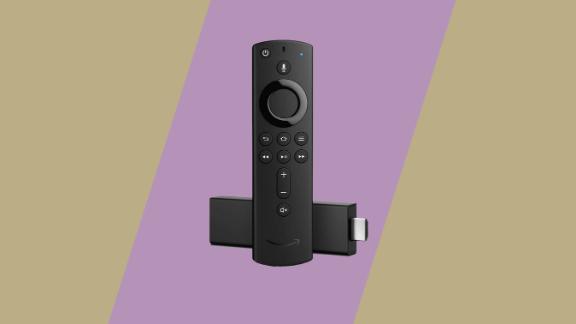
At $49.99, the Fire TV Stick 4K is a device you really can’t go wrong with. It supports 4K HDR streaming and will handle upscaling content — all from a compact design. And, when you buy it through Amazon.com, it’ll come with your account preconfigured.
Our one qualm with the Fire TV Stick 4K is the Fire OS platform. The interface hides core streaming services and other content under some clutter. Recommended TV content and a few ads live in the top side-scroller unit, so you might encounter a row or two before hitting what you want. Not a deal breaker, but it is certainly annoying.
Alexa helps navigate that interface, though. By holding down on the microphone button, you can simply request whatever service you’d like. Say, “Alexa, open Prime Video” (or Netflix or Disney+) and she’ll handle your request. It’s the same Alexa any Echo user is used to, which means you can talk like a normal human and she’ll understand you just fine. And, as with any Alexa-enabled device, you can use voice commands via your Fire Stick to control your smart home or ask for information.
In addition to Prime Video, all the major streaming apps are here (though, as of publish date, Peacock and HBO Max were not yet available). But, as mentioned, the Amazon interface puts a heavy focus on recommendations and pushes the apps you’ve downloaded further down the page. It can be frustrating.
Content looks spectacular, however, with support up to 4K Ultra High Definition. Prime Video really shined in 4K Ultra HD, and content appears both quickly and vibrantly without long wait times for content to load, a problem we experienced with other devices we tested. The Fire TV Stick 4K is pretty close to the performance we saw with the Roku Ultra, and even supports Dolby Vision and Dolby Atmos, which are specific calibrations to improve highlights and contrast for content that supports it.
We’re not in love with the cluttered interface, but Fire TV Stick 4K does a very good job performing its core task, which is streaming content. With Alexa on board, you get the added bonus of smart home control (along with all those fun questions you want to ask her). We’re very comfortable recommending this device at its appealing $49.99 price point.
How we tested
While some of these are sticks and others are boxes, the core use case is to stream content to your TV. And we crafted categories that best reflect that core premise.
Under the Ease of Setup category, we focused on what came in the box and the process for getting the device working. In some cases, it was as simple as plugging it in and connecting to Wi-Fi; for others, we held a device nearby for fast pairing.
Performance tackled more areas, notably the ecosystem, quality across watching the content and available apps and services.
On the quality perspective, we calibrated each streaming device for the TV and then checked out the upscaling. Most importantly, we ensured that it reached 4K UHD or 4K Ultra High Definition as well as checked out the supported standards.
In terms of the build, we looked at the outside and the overall quality of the design. Did the materials live up to the price point? Was space wasted? And what did the controls and ergonomics of the remote mean for the user experience?
We tested all of these streamers with a range of TVs: a 55-inch TCL 6-Series, a 55-inch LG CX55, a 65-inch Sony A8H, a 65-inch TCL 8-Series, a 55-inch Vizio V-Series, a 65-inch Vizio M-Series and a 75-inch Vizio P-Series. Additionally, for the network, we tested hardwired and wirelessly with a FiOS Gigabit connection. We also tried 4G LTE and 5G hot spots from AT&T and T-Mobile for Wi-Fi streamers.
How we rated
Each streaming stick or streaming box was scored in the umbrella categories and then subcategories. Overall performance (with ecosystem, apps and services and quality factored in) was weighted the highest, followed by build quality, ease of setup and warranty.
- Performance had a maximum of 65 points: ecosystem (25 points), including integration with smart home (10 points), casting (10 points) and syncing across devices (5 points); app and service availability (20 points), including core services (10 points), large app store (5 points) and single sign-on (5 points); and quality (20 points), including video (10 points), support for standards (5 points) and sound (5 points).
- Build quality had a maximum of 20 points: controls (10 points), including buttons, ergonomics, design and app and voice control (5 points) and materials (5 points).
- Ease of setup had a maximum of 10 points.
- Warranty had a maximum of 5 points.
Others we tested
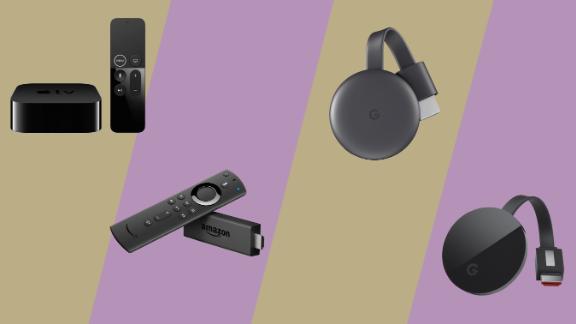
Apple TV ($149.99; bhphotovideo.com)
The standard Apple TV tested nearly as well as the upgraded Apple TV 4K. It has a slightly slower processor but still runs tvOS, offers deep integration to the Apple ecosystem and uses the Siri TV remote. But we think it makes more sense to opt for the Apple TV 4K, as it future-proofs you.
Fire TV Stick ($34.99, originally $39.99; amazon.com)
The non-4K Fire TV Stick is nearly identical to the 4K Fire TV Stick. What’s the big difference? It only supports up to 1080p HD streaming and lacks Dolby Atmos audio. It has the same processor, and in our testing it performed nearly the same. But for $10 more, you’re better off opting for the 4K variant to truly future-proof your TV.
Google Chromecast ($29.99; bhphotovideo.com)
The Chromecast has come a long way, and the current one is quite nice. It still just plugs into the back of your TV and allows you to cast via the “Google Cast” standard to your TV. It doesn’t provide an interface, so you need to use an Android device, iPhone, iPad or laptop to control the experience. To some degree, it’s nice, since you don’t need to re-sign in and can open the Netflix app, hit the Cast icon and send it to the big screen. At $29.99, it’s cheap, and if you’re sold on Google Cast, it’s a good option, but it’s only 1080p HD.
Google Chromecast Ultra ($69; bhphotovideo.com)
As we said, the Achilles’ heel to a degree of a Chromecast was 1080p HD and that it doesn’t have an interface. For $69, the Chromecast Ultra solves part of that. The Ultra supports up to 4K UHD and more than 2,000 services. But for that price, you can score the Roku Ultra, which is a full-fledged streaming box that doesn’t simply rely on your connected phone.
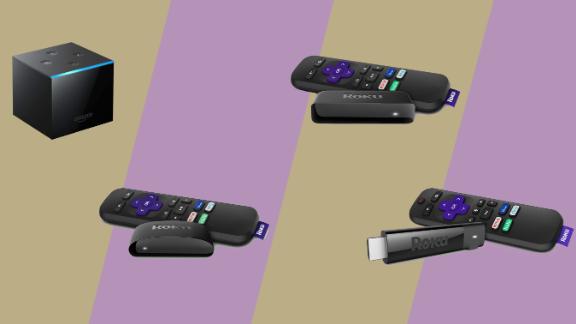
Fire TV Cube ($119.99; amazon.com)
We really enjoyed our time with the Fire TV Cube, but to a degree, it feels like it’s trying to be too much. The premise? It combines an Alexa smart speaker with a Fire TV streaming device. It’s a square box that’s taller than most streaming devices and has the classic blue light strip on the front. You can ask Alexa to turn on the TV, but it doesn’t offer full voice control. Performance-wise, it’s fast and it meets the quality standards with 4K UHD and HDR support.
Roku Express ($24.99, originally $29.99; roku.com)
This is Roku’s entry-level device, which is affordable at $30, but for $10 more, you can get the Streaming Stick+, which is faster, has a voice remote and features 4K UHD streaming. It’s just better by every stretch of the imagination. Although the Express comes with an HDMI cord, we think you’re better off with the Streaming Stick+.
Roku Premiere ($39.99; roku.com)
The Roku Premiere is kind of like an enhanced Roku Express that adds 4K support and keeps the non-voice remote. You also get an HDMI cable, but it’s not as fast as the Streaming Stick+.
Roku Streaming Stick+ ($49.99; roku.com)
Yes, Roku’s Streaming Stick+ is faster than our budget pick and gets a more feature-filled remote. We really like the built-in volume controls but found that voice control wasn’t critical to the core streaming experience. Especially when price was a key focus. If you don’t mind the unique design and a more basic remote, the Roku Premiere still delivers 4K support at an even cheaper price.
Note: The prices above reflect the retailers’ listed price at the time of publication.
Read more from CNN Underscored’s hands-on testing:
"device" - Google News
August 01, 2020 at 01:10AM
https://ift.tt/3ggdaVu
The best streaming sticks and devices of 2020 - CNN
"device" - Google News
https://ift.tt/2KSbrrl
https://ift.tt/2YsSbsy
Bagikan Berita Ini














0 Response to "The best streaming sticks and devices of 2020 - CNN"
Post a Comment